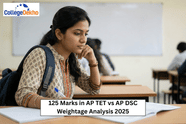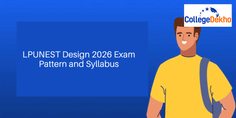
Important Logical Reasoning Questions for CLAT 2026 include questions from resolving paradoxes, identifying assumptions, and supporting or weakening arguments. This section carries a weightage of 28 - 32 questions and accounts for about 25% of the exam. The CLAT Logical Reasoning section contains 4 - 6 passage-based questions. Every passage includes a set of questions, which are based on hypothetical events, current or static legal difficulties, or legal scenarios. The questions test your understanding, analysis, and application of legal laws or principles to specific events.
The CLAT 2026 Logical Reasoning section has the potential to completely change the exam score if prepared well. Hence, we have brought you some Important Logical Reasoning Questions for CLAT 2026 to help you prepare effectively.
Logical Reasoning Questions for CLAT 2026
Here are a few Important Logical Reasoning Questions for CLAT 2026. You can go over these questions and customise your CLAT preparation .
Passage 1
The Indian Parliament passed the "Clean Air and Public Health Act" (CAPHA) in 2024 to respond to the growing urban air pollution problem. According to CAPHA's Section 10, "no factory or commercial establishment shall emit pollutants into the air beyond the permissible limits specified by the Central Pollution Control Board (CPCB...)." Section 12 grants the State Pollution Control Boards the authority to investigate, keep an eye on, and, if required, temporarily close any facility which violates these restrictions. According to Section 15, "any person or organization found violating the permissible limits shall be liable to pay compensation to affected residents and may face additional penalties, including closure orders."
In January 2025, residents of Greenview Colony, a residential neighborhood with a high population density, began to experience more breathing problems. They believed dangerous chemicals were being released at night from the nearest MegaCure Pharmaceuticals plant. The State Pollution Control Board (SPCB) received complaints from a number of locals. Upon investigation, the SPCB discovered that the factory's emissions often exceeded the CPCB-established permissible limits. The SPCB mandated that the plant must be shut down immediately for 30 days and that MegaCure compensate the impacted residents.
MegaCure opposed the decision, claiming that a sudden shutdown would cause severe unemployment and financial loss and that irregular excess emissions were caused by unexpected technological problems. Additionally, the company stated that it was upgrading its pollution control systems. However, residents protested that the law needed to be strictly enforced to stop future infractions and that their health and right to live in cleanliness were being harmed.
The High Court will now have to decide whether the SPCB's actions were permissible under CAPHA and how to find a balance between commercial interests, environmental preservation, and public health.
Question 1: Was it appropriate for the SPCB to force MegaCure Pharmaceuticals to close right away for violating emission limits?
A: Not until the court issues an order.
B: Yes, as the SPCB has the authority to impose closure for violations under Section 12.
C: Not without first giving a warning to the company.
D: Not at all, as the company was updating its systems.
Question 2: What is the main responsibility of factories regarding air pollution under CAPHA?
A: To compensate citizens who file complaints
B: To only release pollutants outside of business hours.
C: To reduce the amount of emissions as much as possible.
D: Avoiding emissions of pollutants over the CPCB-specified allowable limits.
Question 3: Which rule should the High Court apply when settling the conflict between the residents and MegaCure?
A: Whether the company maximizes its earnings.
B: If residents can move.
C: If the SPCB reasonably implemented the principles of CAPHA and followed due process, it would find a balance between public health and economic problems.
D: Whether there are other employers in the vicinity besides the plant.
Question 4: Does MegaCure's claim of financial loss surpass the locals' CAPHA-guaranteed right to a clean environment?
A: No, the Act puts a higher priority on environmental preservation and public health.
B: Only if authorized by the government.
C: Yes, economic concerns always come first.
D: Sure, if the company guarantees continued compliance.
Question 5: Does MegaCure have to compensate impacted residents as is mandated by law?
A: Only if residents have proof of long-term health harm.
B: Only upon a permanent closure of the factory.
C: No, not until a criminal court finds the company guilty.
D: Yes, Section 15 offers impacted residents’ compensation for violations.
Passage 2
The argument over regulating social media networks has heated up in recent years. Governments claim that dangerous content, hate speech, and disinformation spread on these platforms compromise public safety and the principles of democracy. However, others who oppose regulation argue that excessive government involvement affects the right to free speech and expression. They argue that such a law could be utilized to restrict criticism and influence public opinion in the direction of the ruling class.
In the meantime, tech firms claim that they are strengthening their transparency and content moderation rules as part of their efforts to advance self-regulation. However, these initiatives are often criticized for being insufficient or inconsistent. Finding a balance between upholding fundamental rights and making sure social media doesn't turn into an escape for negative activity is the difficult part.
Legal professionals have proposed a co-regulatory strategy that includes neutral monitoring organizations cooperating with governments and platforms. They argue that this arrangement could provide checks and balances while maintaining democratic principles.
Question 1: Which of the following best sums up the writer's take on the social media regulation problem?
A: It is better to completely deregulate platforms to prevent censorship.
B: It is preferable to find a solution that involves both supervision and rights protection.
C: The way platforms are now regulated is enough and doesn't need to be changed.
D: The only practical remedy for disinformation is government action.
Question 2: Which of these presumptions must be true for legal professionals to believe that co-regulation is a workable model?
A: Social media businesses are simply unable to control themselves.
B: Governments are prepared to give up complete authority over speech on digital platforms.
C: The general population prefers regulated content to unlimited access.
D: Independent monitoring bodies can continue to operate without corporate or political control.
Question 3: What effect might government laws have on the argument made in the paragraph if future research reveals that they resulted in persecution of minority opinions?
A: It would confirm worries about excessive government power.
B: It would make co-regulation less credible.
C: It would support the argument for complete government authority.
D: It would make the case for self-regulation weaker.
Question 4: What is the primary social media regulation issue raised in the passage?
A: Minimizing public internet usage.
B: Balancing the protection of dangerous content with the right to free expression.
C: Finding a balance between limiting harmful information and allowing free expression.
D: Promoting increased usage of social media platforms.
Question 5: Why do governments think social media regulation is necessary?
A: To generate income for tech companies.
B: To protect democracy and public safety against offensive content.
C: To improve the available entertainment.
D: To make ruling parties more popular.
Passage 3
Read the information thoroughly, then answer the questions according to the seating arrangement:
"Sohan, Ram, Shyam, Rohit, Mohit, Rakesh, and Suresh are seated in a circle with their backs to the centre. Rohit is positioned in the third place to the left of Ram. Rohan is seated in the fourth place, towards the right of Ram. Mohit is positioned fourth to the left of Suresh, who is positioned second to Ram's right. Sohan is seated in the third place towards the right of Shyam. Mohan is not seated next to Ram.
Question 1: What is the position of Rakesh toward Rohan?
A: Fourth towards the left.
B: Third to the right.
C: Fifth towards the left of the ram.
D: Fourth towards the right.
Question 2: Who is third to Mohan's right?
A: Ram
B: Shyam
C: Rohit
D: Ritesh
Question 3: Who is the person fifth to Rohan's right?
A: Mohan
B: Suresh
C: Rakesh
D: Rohit
Question 4: Who is seated immediately to the right of Mohit?
A: Rohan
B: Rohit
C: Ritesh
D: Ram
Question 5: Who is positioned at the third place to the right of Sohan?
A: Ram
B: Rakesh
C: Shyam
D: Mohit
Passage 4
Where are all the aliens, considering the ancient history of the cosmos and the seeming likelihood that life evolved on other planets orbiting other stars? Research conducted in 2015 using information from the Kepler and Hubble Space Telescopes might offer an explanation: Earth bloomed early. According to the study, which focuses on the probability that habitable worlds will evolve, our planet was born from the protoplanetary disk of our young sun some 4.6 billion years ago, during a time when only "8 percent of the potentially habitable planets that will ever form in the universe existed." The majority of the material needed to create habitable planets is still there, so there is still time for alien civilizations to appear and communicate with us.
Question 1: Which of the items listed below best describes the author's claim that alien life exists?
A: The universe is sufficiently young to support the evolution of alien life.
B: Other planets circling other stars in the universe have not yet developed alien civilizations.
C: Even if it hasn't developed yet, alien life is quite probable to do so in the universe.
D: Given the long history of the universe, the likelihood of alien life arising is significant.
Question 2: Out of the following claims, which one most accurately defines the 2015 research findings?
A: There is a mere 8% possibility that Earth is the sole planet in the universe with life on it.
B: 92% of the universe's planets are still forming.
C: The likelihood of humans coming across life on other habitable worlds is 92%.
D: Earth was created early in the universe's existence, making it livable.
Question 3: In reference to aliens, the author assumes that:
A: They will probably develop into like-minded people.
B: They will be excited to contact us.
C: They might not even know we exist.
D: They will be capable of space travel.
Question 4: The author argues that the reason we haven't heard from aliens yet is
A: The Earth most likely evolved life before any other planet.
B: The universe has not yet created any alien civilizations.
C: There hasn't been time for the universe to create a large number of more livable worlds.
D: None of the above.
Question 5: Assume that, of all the planets that are now in existence, Earth is the last to form, having produced just 80% of the others. This data:
A: Weakens the point made by the author.
B: Supports the author's claim
C: Doesn't impact the author's claim.
D: Invalidates the author's thesis in every aspect.
Important Note: All the correct answers are highlighted in bold.
Also Read:
What is a Good Score in CLAT 2026?
Important Topics for CLAT 2026 Logical Reasoning
It is crucial to have a general understanding of the most important topics for the CLAT 2026 logical reasoning section before beginning any preparation. These important topics include the following:
- Arrangements
- Syllogisms
- Blood Relations
- Number Series
- Statements and Assumptions
- Logical Sequences
- Seating Arrangement/Puzzle Test
- Arguments & Conclusions
- Assertions and Reasoning
- Puzzles
- Circular Arrangements
- Direct sense
- Coding Decoding
- Analogies
- Clocks and calendars
- Connectives
Preparation Tips for CLAT 2026 Logical Reasoning
Here are some important preparation tips for the CLAT 2026 logical reasoning section:
- Prepare a list of all the important topics and set a deadline for yourself to complete the Logical Reasoning course by that time.
- Set aside at least an hour each day to prepare for the CLAT 2026 logical reasoning section.
- Avoid memorizing information. Instead, try to understand the concepts and reasoning. Practice answering as many questions as you can on different topics when you have a firm grasp of the concepts.
- Starting with the topics you are most proficient with and working your way up to the more difficult ones.
- There are several shortcuts you need to learn to answer Logical Reasoning questions more quickly. It is highly important to learn and use shortcuts for topics like blood relations and syllogisms.
- Expand your analytical skills for solving difficult problems requiring logical reasoning. To develop a sharp and analytical mind, solve puzzles, and read editorials, and articles regularly.
- Use Venn diagrams or flowcharts to better visualize information that has logical connections or sequences. You can use this technique to help you solve difficult problems in the CLAT 2026 exam.
- Solve as many CLAT previous year question papers as you can after finishing your CLAT Logical Reasoning syllabus.
- It is recommended that you must focus particularly on completing the question paper and CLAT mock tests for 2026, as they are based on the updated exam format.
- Continue revising the topics and concepts you have already learned to maintain your syllabus understanding.
Now, you have some Important Logical Reasoning Questions for CLAT 2026 on your table. Start preparing from now onwards to ace the exam. Logical reasoning is one of the hardest and highest-scoring sections of the CLAT 2026 exam. Hence, focus on making your fundamentals strong, practice as many questions as you can, and take mock tests regularly.
Are you feeling lost and unsure about what career path to take after completing 12th standard?
Say goodbye to confusion and hello to a bright future!

FAQs
Candidates should regularly practice answering various types of logical reasoning questions to enhance their performance in this area. They can also enroll in offline or online coaching courses, which are especially designed to help them with CLAT logical reasoning.
Candidates must thoroughly read and understand the information provided to answer logical thinking questions accurately. After that, they should analyze the connections, trends, and options to the questions and apply reasoning to choose the right answer.
Yes. It is important to stay updated with legal news and current affairs since certain passages and questions are based on recent legal developments, changes, or landmark decisions.
Passages are usually 300–450 words long, followed by 4–6 questions each.
The logical reasoning section in the CLAT exam consists of questions such as, reading a legal case and using a principle or rule to answer relevant questions. It assesses legal aptitude, logical thinking, and comprehension.
Was this article helpful?





















Similar Articles
AILET General Category Cutoff 2026: Check expected cutoff, previous years' trends
AILET 2026 Exam Day Guidelines: Do's and Don'ts
Delhi LLB Admission 2026
LPUNEST Law 2026 Exam Pattern: Details, Syllabus & Best Books
LPUNEST for LLB and Integrated Law Course
AILET 2026 Seats for SC Category: Total No. of Seats with Fees